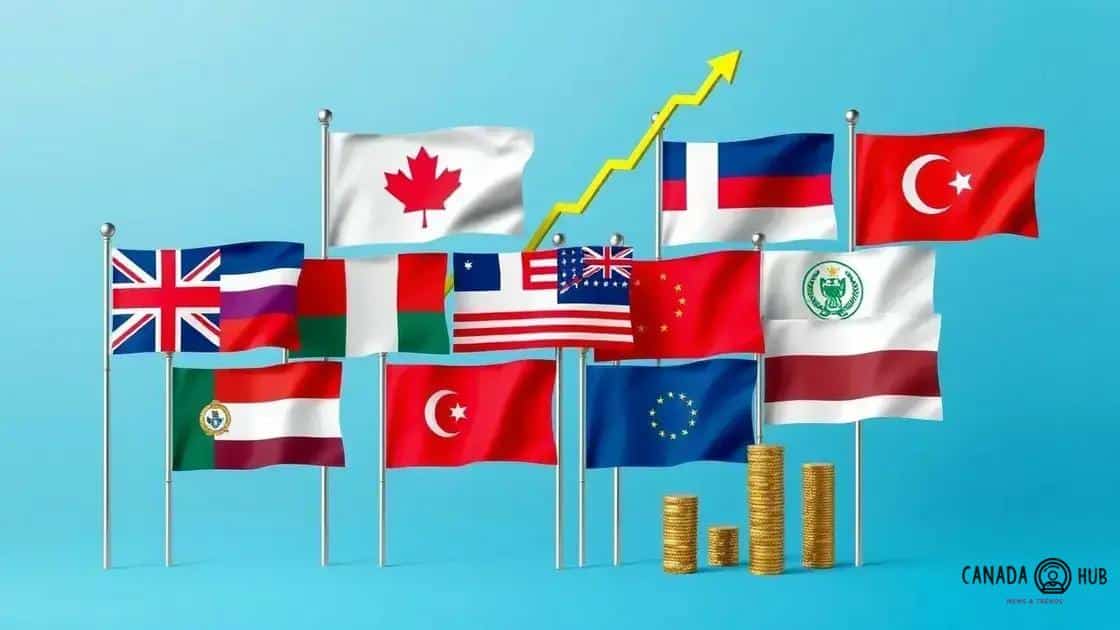Federal Reserve’s consideration of unconventional monetary policies

The Federal Reserve’s consideration of unconventional monetary policies aims to stimulate economic growth during crises but involves potential risks like inflation, asset bubbles, and increased income inequality.
The Federal Reserve’s consideration of unconventional monetary policies opens up a realm of possibilities for our economy. Have you ever wondered how these strategies could affect interest rates and inflation? Let’s dive into this intriguing topic.
Understanding unconventional monetary policies
Understanding unconventional monetary policies is crucial in today’s economic landscape. These measures are often taken when traditional ones become ineffective, especially during times of crisis. Have you ever wondered how central banks adapt to unforeseen challenges? Let’s explore this fascinating topic.
What Are Unconventional Monetary Policies?
Unconventional monetary policies include actions that go beyond the usual techniques a central bank uses. They are designed to stimulate the economy, particularly when interest rates are already near zero. Some of these policies include:
- Quantitative easing (QE)
- Negative interest rates
- Forward guidance
- Asset purchase programs
Each policy has its own strategy and potential impact. For instance, quantitative easing involves the central bank purchasing government securities to inject money into the economy.
Why Are These Policies Necessary?
During economic downturns, traditional tools like lowering interest rates may not be enough. Unconventional monetary policies provide additional options to encourage spending and investment. They aim to boost employment and stabilize prices. The effectiveness of these policies can vary and often depends on the specific economic environment.
Central banks monitor various indicators to determine when to implement these policies. These indicators include inflation rates, unemployment figures, and overall economic growth. By analyzing these factors, they can decide how to best support the economy.
The Impact of Unconventional Policies
Unconventional policies can have widespread effects on financial markets and the overall economy. They often lead to:
- Lower borrowing costs
- Increased asset prices
- Greater liquidity in the financial system
- Potential currency depreciation
This allows businesses to invest more and consumers to spend, which can ultimately lead to economic recovery. However, it also raises questions about long-term consequences, such as inflation and asset bubbles.
Understanding the nuances of unconventional monetary policies helps clarify how economies can respond in challenging times. By examining the methods and their impacts, we gain insight into our financial future. As central banks navigate these waters, the importance of these measures will continue to be a central topic among economists and policymakers.
Impact of unconventional approaches on the economy

The impact of unconventional approaches on the economy is profound and multifaceted. When central banks implement these policies, they aim to address unique challenges that traditional measures cannot solve. Understanding these effects helps us appreciate how monetary policy shapes our financial landscape.
Short-term Effects
Initially, unconventional policies can lead to swift changes in economic conditions. For example, when the Federal Reserve opts for quantitative easing, they inject money into the economy, which can lower interest rates and encourage borrowing. This fosters consumer spending and business investments.
- Increased liquidity in financial markets
- Lower interest rates for loans
- Boosted business confidence
- Higher consumer spending
These changes can create a cycle of growth, leading to improved economic performance. However, the long-term consequences require careful examination.
Long-term Consequences
While short-term impacts can be positive, the long-term effects of unconventional monetary policies can raise concerns. For instance, injecting too much money into the economy may lead to inflation. Additionally, prolonged periods of low interest rates can result in risky investments, which could lead to asset bubbles.
Furthermore, these policies can affect income inequality. As asset prices rise, those with investments benefit more than those without, widening the gap. Understanding how these policies impact different segments of the population is crucial for policymakers.
As central banks continue to use unconventional approaches, maintaining a balance between stimulating growth and managing risks is essential. Economists and financial experts closely monitor market reactions and economic indicators to assess the effectiveness and consequences of these policies.
How the Federal Reserve evaluates these options
How the Federal Reserve evaluates these options is an essential aspect of its role in the economy. When considering unconventional monetary policies, the Fed uses a systematic approach to assess their potential effectiveness. This process involves analyzing various economic indicators and trends.
Key Economic Indicators
The evaluation process starts by looking at several key economic indicators. These indicators help the Fed gauge the current state of the economy. Some of them include:
- Inflation rates: Tracking inflation helps the Fed understand pricing stability.
- Unemployment rates: High unemployment signals the need for economic stimulation.
- GDP growth: Measuring economic growth is crucial for understanding overall health.
- Consumer spending: This reflects confidence and activity within the economy.
By closely monitoring these indicators, the Federal Reserve can make informed decisions about implementing unconventional policies.
The Decision-Making Process
The decision-making process itself involves collaboration among various departments within the Fed. Economists and analysts present data and forecasts to the Federal Open Market Committee (FOMC). They discuss the potential impacts of proposed policies on economic growth and inflation rates. This collaborative effort ensures a comprehensive evaluation.
During meetings, the FOMC considers different scenarios and models to predict outcomes. This predictive modeling is crucial for assessing the risks and benefits of each policy option. Additionally, the Fed consults with other institutions and experts to gather diverse perspectives, further enhancing their evaluations.
The Fed also takes into account public sentiment and market reactions. Understanding how the public and markets might respond to policy changes can influence their final decisions. This responsiveness helps the Fed maintain credibility and trust in its actions.
Evaluating these options is not a straightforward task. The Federal Reserve constantly navigates complexities and uncertainties within the economy. By systematically analyzing data and consulting with experts, the Fed aims to implement the most effective monetary policies.
Success stories from other countries

Success stories from other countries provide valuable insights into how unconventional monetary policies can effectively stimulate economic growth. By examining these examples, we can understand the potential benefits and strategies used by different nations.
Japan’s Quantitative Easing
One notable example is Japan, which implemented quantitative easing in the early 2000s. Faced with deflation and stagnant growth, the Bank of Japan started purchasing government bonds and securities. This move aimed to increase liquidity in the economy and encourage spending.
- The policy helped lower interest rates.
- It supported asset prices, leading to increased consumer and business confidence.
- Japan experienced moderate growth and a gradual rise in inflation.
Over time, Japan’s economy showed signs of recovery, demonstrating the effectiveness of unconventional strategies.
European Central Bank Initiatives
The European Central Bank (ECB) has also had successes with its policies. In response to the Eurozone crisis, the ECB launched its Asset Purchase Program. This program aimed to combat low inflation and stimulate economic activity.
Among its effects, it led to:
- Lower borrowing costs across member states.
- Increased investments in various sectors.
- A boost in consumer spending due to greater confidence in economic recovery.
The ECB’s efforts contributed to a more stable economic environment within Europe, showcasing how coordinated monetary policies can lead to positive outcomes.
U.S. Experience after the 2008 Financial Crisis
The United States is another case worth noting. Following the 2008 financial crisis, the Federal Reserve implemented **unconventional monetary policies** such as quantitative easing and forward guidance. These policies aimed to revive the economy by supporting financial markets and encouraging lending.
The results were significant:
- Unemployment rates decreased.
- The stock market recovered and grew substantially.
- The economy experienced sustained growth over the following years.
These examples illustrate the potential of unconventional policies in driving economic recovery and stability. The careful application of these strategies has enabled countries to navigate complex economic challenges successfully.
Potential risks and challenges involved
While unconventional monetary policies can offer significant benefits, they also come with potential risks and challenges. Understanding these dangers is essential for policymakers and the public alike.
Risk of Inflation
One of the major concerns associated with these policies is the risk of inflation. When a central bank increases the money supply too rapidly, it can lead to higher prices. If inflation rises beyond acceptable levels, it can erode purchasing power and savings.
- Excess liquidity can push prices up.
- Consumers may feel the pinch as their money buys less.
- Central banks may need to tighten policies, potentially slowing recovery.
Inflation management becomes crucial in ensuring economic stability.
Asset Bubbles
Another significant risk is the formation of asset bubbles. Prolonged periods of low interest rates and easy access to credit can encourage excessive risk-taking in financial markets. When prices for assets like stocks or real estate become artificially inflated, it increases the chance of a sudden downturn.
This can lead to devastating financial consequences for investors and broader economic instability. Recent history has shown how quickly these bubbles can burst, leading to rapid declines in market values.
Income Inequality
Unconventional monetary policies can also exacerbate income inequality. While these strategies may lead to overall economic growth, the benefits are not always evenly distributed. Wealthy individuals who own financial assets often see significant gains from rising prices, while those who rely solely on wages may not benefit similarly.
This growing disparity can lead to social and economic tensions, complicating the overall impact of these policies.
Market Volatility
The implementation of unconventional approaches can lead to increased volatility in financial markets. Uncertainty about the future direction of federal policies can prompt rapid changes in investor behavior, causing fluctuations in asset prices.
This volatility can undermine confidence in financial markets, making investors more cautious and potentially slowing economic growth. Keeping markets stable while using these policies is a constant balancing act for central banks.
Awareness of these potential risks and challenges is vital for effective economic policy. As governments and central banks navigate the complexities of monetary policy, a careful approach is necessary to ensure that the benefits outweigh the drawbacks.
FAQ – Frequently Asked Questions about Unconventional Monetary Policies
What are unconventional monetary policies?
Unconventional monetary policies are strategies used by central banks, like quantitative easing, to stimulate the economy when traditional methods are ineffective.
How do these policies impact inflation?
These policies can increase the money supply, which may lead to higher inflation if not managed carefully.
Can unconventional monetary policies increase income inequality?
Yes, benefits from these policies can disproportionately favor wealthier individuals who own financial assets, widening the income gap.
What lessons can we learn from other countries?
Countries that have successfully implemented these policies provide valuable insights, helping others avoid risks and improve their own strategies.





